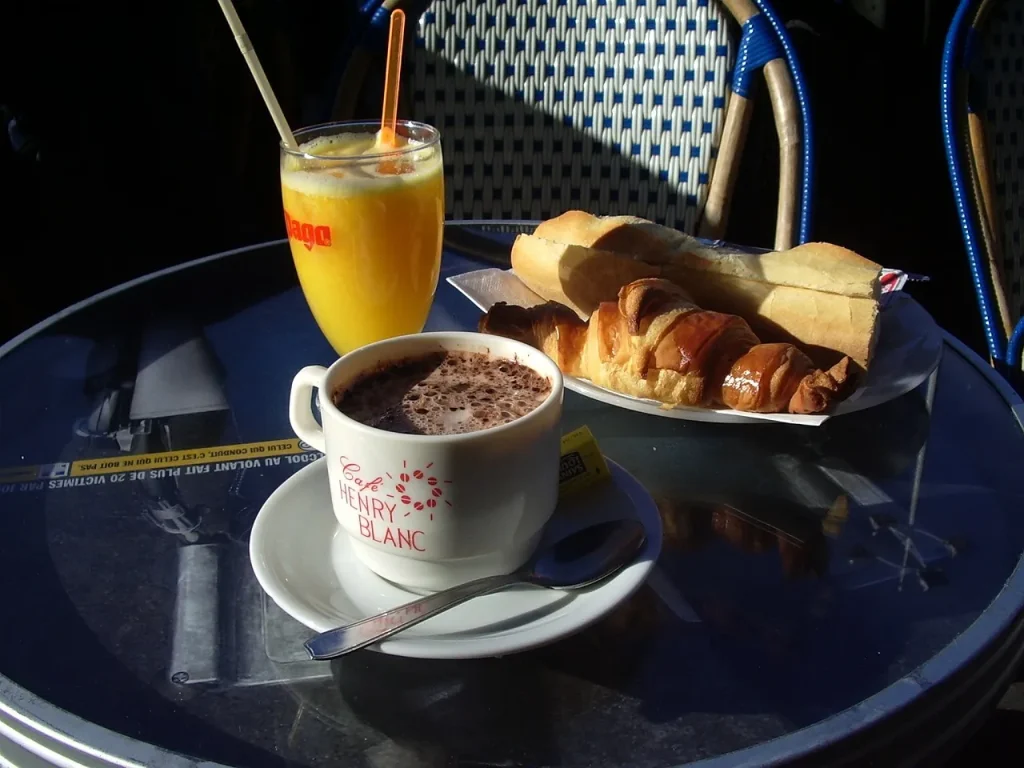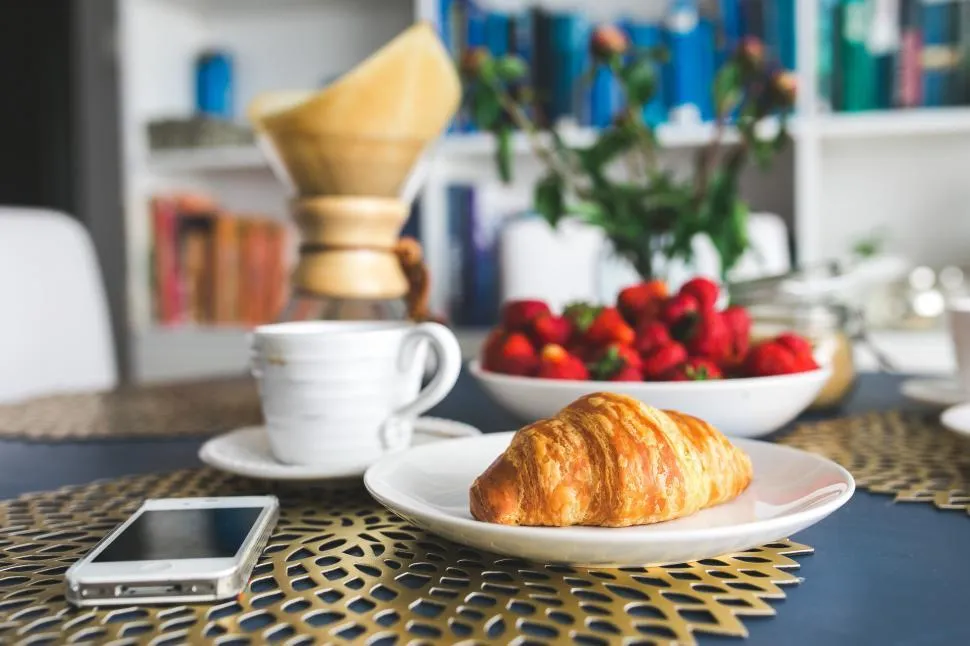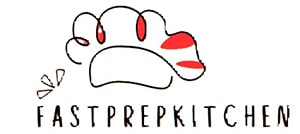The Best Fluffy Pancakes recipe you will fall in love with. Full of tips and tricks to help you make the best pancakes.
There’s something effortlessly elegant about a classic French breakfast. Unlike the hearty, savory breakfasts found in other cultures, the French morning meal is all about simplicity, balance, and high-quality ingredients. A warm, flaky croissant, a crusty baguette with butter and jam, and a steaming cup of café au lait create the perfect start to the day.
French breakfasts aren’t just about the food—they’re about the experience. The French take their time in the morning, savoring each bite and sip, often in a cozy café or at home with a beautifully set table. Whether you’re indulging in pain au chocolat, dipping a tartine into your coffee, or enjoying a light yogurt with honey, the key is to embrace the effortless charm of French cuisine.
In this guide, we’ll explore the essential elements of a French breakfast, must-try recipes, and simple tips to help you recreate this delightful experience in your own home. Grab your favorite pastry and let’s dive in!
What Makes a French Breakfast Classic?
A French breakfast is distinct from the heavy, protein-packed breakfasts found in other parts of the world. Instead of eggs, bacon, and hash browns, the French opt for a lighter, more refined approach that highlights pastries, bread, butter, and coffee. But what exactly makes a French breakfast classic? Let’s break it down:

1. The Focus on Pastries and Bread
One of the hallmarks of a French breakfast is the emphasis on freshly baked pastries and bread. Unlike American or English breakfasts, where a variety of hot dishes dominate the table, French breakfasts center around simple, yet incredibly flavorful baked goods. Some of the most popular options include:
- Croissants – Buttery, flaky, and golden, these are a breakfast staple in France. Best enjoyed warm with coffee or tea.
- Baguette with Butter and Jam (Tartine) – A fresh, crusty baguette sliced and spread with high-quality French butter and jam (such as Bonne Maman or St. Dalfour).
- Pain au Chocolat – A pastry similar to a croissant but filled with rich, dark chocolate, perfect for those with a sweet tooth.
- Brioche – A soft, slightly sweet bread enriched with butter and eggs, often enjoyed plain or lightly toasted.
These simple yet high-quality baked goods form the foundation of a traditional French petit déjeuner (breakfast).
2. The Role of Coffee and Tea
A classic French breakfast is incomplete without a steaming cup of café au lait—a rich blend of coffee and warm milk served in a large bowl for easy dipping. Other popular morning drinks include:
- Espresso – Strong and bold, often enjoyed in small cups.
- Café Noir – A black coffee, similar to an Americano, but with a French touch.
- Thé (Tea) – Light and aromatic, often paired with a slice of lemon or a touch of honey.
- Hot Chocolate (Chocolat Chaud) – Thick and indulgent, made with real melted chocolate and steamed milk, a favorite among children and adults alike.
Unlike in some cultures where breakfast beverages are served to-go, the French prefer to sit and savor their drinks slowly, often while dipping a piece of baguette or croissant into their coffee.
3. The Importance of Simple Yet High-Quality Ingredients
The French have a deep appreciation for quality over quantity, and this is reflected in their breakfast habits. While their morning meal may seem minimal, every component is made with fresh, high-quality ingredients. Key elements include:
- Butter (Beurre d’Isigny, Président Butter) – Rich, creamy, and often slightly salted, French butter is a key ingredient for spreading on bread.
- Jam (Bonne Maman, St. Dalfour) – Unlike overly sweetened jams found elsewhere, French jams are made with natural fruit flavors and less sugar.
- Freshly Baked Bread – Rather than packaged or pre-sliced bread, the French visit local boulangeries for fresh baguettes and pastries.
- Simple Yogurt and Cheese – While not always part of the classic breakfast, plain yogurt with honey or a slice of cheese can be enjoyed as a lighter alternative.
4. The French Approach to Breakfast: A Relaxed and Enjoyable Experience
Beyond the food itself, what makes a French breakfast truly classic is the way it is enjoyed. The French treat breakfast as a moment to slow down and savor their meal, whether at home or in a charming Parisian café. Unlike the grab-and-go culture of many other countries, breakfast in France is meant to be relaxing and pleasurable.
Some key aspects of the French breakfast experience include:
- Sitting at a café terrace, sipping coffee while watching the world go by.
- Taking the time to enjoy every bite, rather than rushing through the meal.
- Prioritizing quality ingredients over large portions.
- Keeping breakfast simple yet satisfying, with no unnecessary complexity.
Essential French Breakfast Foods You Need to Try
A classic French breakfast is all about simplicity, high-quality ingredients, and a balance of sweet and savory flavors. Unlike heavy breakfasts with eggs, bacon, and sausages, French breakfasts are typically lighter, yet satisfying, focusing on pastries, bread, butter, jam, coffee, and sometimes dairy products like yogurt and cheese.
If you’re looking to recreate an authentic French breakfast at home or just want to explore new breakfast ideas, here are some must-try French breakfast foods:

1. Croissants and Pain au Chocolat: Buttery and Flaky Delights
No French breakfast is complete without a croissant. These golden, flaky pastries are made through a process called laminating, where layers of dough and cold butter are folded and rolled multiple times to create an airy texture. After proofing, they are brushed with egg wash and baked until crisp and golden brown. The result? A light, buttery pastry that melts in your mouth.
For those with a sweet tooth, Pain au Chocolat is the ultimate treat. It follows the same laminated dough process but is shaped into a rectangle and filled with rich, dark chocolate before baking. The chocolate melts inside, creating a gooey, indulgent center wrapped in a crisp, buttery shell.
How to Make Croissants and Pain au Chocolat
Ingredients:
- 4 cups (500g) all-purpose flour
- 1/4 cup (50g) granulated sugar
- 2 1/4 tsp (1 packet) active dry yeast
- 1 1/4 tsp salt
- 1 cup (240ml) warm milk
- 1 cup (225g) unsalted butter, cold
- 1 egg (for egg wash)
- 4 oz (115g) dark chocolate (for Pain au Chocolat)
Instructions:
- Prepare the Dough: Dissolve the yeast in warm milk and let it sit for 5 minutes. In a mixing bowl, combine flour, sugar, and salt. Slowly mix in the yeast mixture and knead until smooth. Cover and chill for 2 hours.
- Laminating the Butter: Roll out the dough into a rectangle, place the cold butter in the center, and fold the dough over it. Roll and fold 3-4 times, chilling in between to create flaky layers.
- Shape the Croissants: Roll the dough into a large rectangle, cut triangles, and roll them into croissant shapes. For Pain au Chocolat, cut the dough into rectangles, place a chocolate strip inside, and roll tightly.
- Proofing: Place the shaped pastries on a baking sheet, cover, and let rise for 2 hours.
- Bake: Brush with egg wash and bake at 375°F (190°C) for 18-20 minutes, until golden brown.
Tip: If you want to make your French breakfast truly authentic, visit a local boulangerie (bakery) early in the morning to get croissants fresh out of the oven. Or, try making them at home for a rewarding baking project!
2. Baguette with Butter and Jam (Tartine): A Simple and Classic Staple
A tartine is a French open-faced breakfast toast, often made with freshly baked baguette slices spread with high-quality French butter and jam. The simplicity of this dish highlights the importance of using the best ingredients.
For the perfect tartine, use:
- A fresh, crusty baguette – Authentic French baguettes are made with just flour, water, yeast, and salt. The dough is kneaded, shaped into long loaves, and baked at high heat to create a crispy crust and airy crumb.
- High-quality butter – Traditional French butter, such as Beurre d’Isigny or Président Butter, has a higher fat content, making it extra creamy.
- Fruit jams and spreads – Classic French jams include Bonne Maman’s strawberry, raspberry, apricot, or fig. A drizzle of lavender honey or Nutella is also a delicious option.
How to Make a Traditional French Baguette
Ingredients:
- 3 1/2 cups (450g) bread flour
- 1 1/2 tsp salt
- 2 1/4 tsp (1 packet) active dry yeast
- 1 1/4 cups (300ml) warm water
Instructions:
- Activate the Yeast: In a bowl, mix warm water and yeast. Let it sit for 5 minutes until foamy.
- Make the Dough: Add flour and salt, then knead for about 10 minutes until smooth. Cover and let rise for 1-2 hours.
- Shape and Proof: Divide the dough into two loaves, shape into baguettes, and let them rest for another hour.
- Bake: Preheat the oven to 475°F (245°C). Score the tops, bake for 20-25 minutes, and cool before slicing.
Tip: For the ultimate experience, enjoy your tartine with a hot cup of café au lait and dip your bread in the coffee, just like the French do!a sprinkle of sea salt, or a spread of Nutella for a more indulgent twist.
3. Café au Lait and Hot Chocolate: The Perfect French Morning Drinks
A true French breakfast experience wouldn’t be complete without the right beverage. The two most traditional morning drinks in France are:
- Café au Lait – A comforting mix of strong coffee and steamed milk, typically served in a large bowl rather than a cup, allowing for easy dipping of croissants or tartines.
- Chocolat Chaud (Hot Chocolate) – A rich, creamy drink made with melted dark chocolate and hot milk, often topped with whipped cream. Unlike instant hot chocolate, French hot chocolate is thicker, darker, and more decadent.
How to Make French Café au Lait and Hot Chocolate
Café au Lait Ingredients:
- 1 cup (240ml) strong brewed coffee
- 1 cup (240ml) steamed milk
Instructions:
- Brew strong coffee using a French press or espresso machine.
- Heat milk until steaming but not boiling.
- Pour equal parts coffee and milk into a large bowl or mug and serve immediately.
Chocolat Chaud Ingredients:
- 2 cups (500ml) whole milk
- 4 oz (115g) dark chocolate, finely chopped
- 1 tbsp sugar (optional)
- Whipped cream (optional)
Instructions:
- Heat the milk in a saucepan over medium heat.
- Add the chopped chocolate and whisk until smooth and melted.
- Sweeten if desired, pour into a cup, and top with whipped cream.
Tip: If you prefer a stronger coffee, go for an espresso or café noir (black coffee), which are also common morning drinks in France.offee, go for an espresso or café noir (black coffee), which are also common morning drinks in France.
4. French Toast (Pain Perdu): A Decadent Breakfast Classic
Did you know that French toast actually originated in France? Called Pain Perdu (meaning “lost bread”), this dish was originally created as a way to use up stale bread. Instead of wasting old bread, it was soaked in a mixture of eggs, milk, sugar, and vanilla, then pan-fried in butter until golden brown.
How to Make Classic Pain Perdu
Ingredients:
- 4 slices of stale baguette or brioche
- 2 eggs
- 1/2 cup (120ml) milk
- 1 tbsp sugar
- 1 tsp vanilla extract
- Butter for frying
- Powdered sugar, maple syrup, or fruit for topping
Instructions:
- Prepare the Batter: In a bowl, whisk eggs, milk, sugar, and vanilla.
- Soak the Bread: Dip the bread slices into the mixture, letting them absorb for 20-30 seconds.
- Cook: Heat butter in a pan and fry the soaked bread for 2-3 minutes per side until golden.
- Serve: Dust with powdered sugar, drizzle with syrup, or top with fresh fruit.
Tip: While baguette slices are traditional for Pain Perdu, using brioche makes it even richer and more indulgent!
5. Brioche and Madeleines: Soft, Sweet Breakfast Treats
If you prefer soft, slightly sweet breads for breakfast, you’ll love these classic French options:
- Brioche – A rich, buttery bread with a slightly sweet flavor. It has a tender crumb and is perfect on its own, toasted with jam, or even turned into French toast (Pain Perdu).
- Madeleines – These small, shell-shaped sponge cakes are light, fluffy, and ideal for dipping into coffee or tea. They have a delicate vanilla and buttery flavor, sometimes with a hint of lemon.
How to Make Classic French Brioche
Ingredients:
- 3 1/2 cups (450g) all-purpose flour
- 1/4 cup (50g) sugar
- 1 tsp salt
- 2 1/4 tsp (1 packet) active dry yeast
- 4 eggs
- 1/2 cup (120ml) warm milk
- 1 cup (225g) unsalted butter, softened
Instructions:
- Activate the Yeast: In a small bowl, dissolve yeast in warm milk and let it sit for 5-10 minutes.
- Make the Dough: In a large bowl, mix flour, sugar, and salt. Add the yeast mixture and eggs, then knead until smooth. Gradually add butter, kneading until fully incorporated.
- First Rise: Cover and let the dough rise for 2 hours at room temperature or overnight in the fridge.
- Shape and Proof: Shape into a loaf or small rolls, place in a greased pan, and let rise for another hour.
- Bake: Preheat the oven to 375°F (190°C) and bake for 25-30 minutes, until golden brown.
How to Make Traditional French Madeleines
Ingredients:
- 1/2 cup (115g) unsalted butter, melted and cooled
- 3/4 cup (95g) all-purpose flour
- 1/2 tsp baking powder
- 2 eggs
- 1/3 cup (70g) sugar
- 1 tsp vanilla extract
- Zest of 1 lemon (optional)
Instructions:
- Prepare the Batter: Whisk eggs and sugar until pale and fluffy. Stir in vanilla and lemon zest.
- Combine Ingredients: Sift in flour and baking powder, gently folding it into the batter. Add melted butter and mix until smooth.
- Chill: Cover and refrigerate the batter for at least 1 hour (this helps create the signature hump).
- Bake: Preheat oven to 375°F (190°C). Butter a madeleine mold, fill each cavity with a spoonful of batter, and bake for 10-12 minutes until golden.
- Serve: Let cool and dust with powdered sugar if desired.
Tip: Serve madeleines warm with a side of tea or hot milk for a comforting breakfast experience.
6. Yogurt with Honey and Nuts: A Healthy French Breakfast Alternative
For those looking for a lighter, healthier breakfast, many French people opt for yogurt with honey and nuts. Unlike overly sweetened yogurts found in some countries, French yogurts are typically plain or lightly sweetened. They are often made with whole milk for a creamier texture and paired with fresh fruit, honey, and nuts for added flavor.
How to Make a French-Style Yogurt Bowl
Ingredients:
- 1 cup (250g) whole milk yogurt (Greek-style or traditional French yogurt)
- 1 tablespoon lavender honey (or regular honey)
- 2 tablespoons almonds or walnuts, crushed
- 1/2 cup fresh fruit (berries, figs, or sliced apples)
- A sprinkle of granola or chia seeds (optional)
Instructions:
- Assemble: Spoon the yogurt into a bowl.
- Top: Drizzle with honey, then sprinkle the nuts and fresh fruit on top.
- Serve: Enjoy immediately for a nutritious and balanced breakfast.
Tip: Try using lavender honey and crushed almonds for an authentic French-inspired twist.
How to Recreate a Parisian Breakfast at Home
Bringing the charm of a Parisian café to your own kitchen is easier than you think. The key is to focus on quality ingredients, simple preparation, and a relaxed morning ambiance.
Start by selecting fresh bread and pastries. A crispy baguette, buttery croissants, or pain au chocolat are staples of a French breakfast. Lightly toast the bread and serve it with butter, jam, or honey for an authentic touch.
Next, prepare a delicious cup of coffee, which is an essential part of a French morning ritual. A rich and aromatic brew pairs perfectly with freshly baked pastries for a truly Parisian experience.
For those who enjoy a touch of sweetness in the morning, Cinnamon French Toast is a delicious option to add to your breakfast spread. While not traditionally French, this dish pairs wonderfully with fresh fruit and a drizzle of maple syrup, creating a comforting and flavorful morning treat.
To complete the experience, serve freshly squeezed orange juice in a small glass and set the table with simple but elegant tableware. A small dish of yogurt with granola or fruit can add a fresh and balanced touch to your breakfast.
Here’s how you can create an authentic Parisian-style breakfast in your own kitchen.

1. Start with Fresh, High-Quality Pastries and Bread
A true Parisian breakfast begins with freshly baked pastries and bread, preferably from a local bakery or homemade if you enjoy baking. The French emphasize quality over quantity, so focus on getting authentic ingredients rather than piling your plate with different items.
The must-have baked goods include:
- Croissants – Buttery, flaky, and golden brown, these are best served warm. You can buy them fresh from a local bakery or bake your own for an extra homemade touch.
- Pain au Chocolat – A chocolate-filled pastry, perfect for those who love a sweet start to their day.
- Baguette – A fresh, crusty baguette is essential. Slice it and serve it with butter, jam, or honey. This is known as a tartine, a French breakfast classic.
- Brioche – A soft, slightly sweet bread enriched with butter and eggs, ideal for toasting and topping with jam or honey.
Tip: If you don’t have access to a local bakery, consider baking your own croissants or baguettes at home. It takes time, but the reward is worth it!
2. Set Up the Perfect Hot Beverage
In France, breakfast is always accompanied by a warm, comforting drink. The most popular choices include:
- Café au Lait – A mix of strong coffee and steamed milk, often served in a large bowl instead of a mug. This allows for easy dipping of bread and croissants.
- Espresso – A small but strong shot of coffee for those who prefer a more intense flavor.
- Chocolat Chaud (French Hot Chocolate) – Made with melted dark chocolate and whole milk, this drink is much richer and creamier than instant hot chocolate. Some versions even include a touch of cream for extra indulgence.
- Tea – A cup of high-quality black tea or an herbal infusion is also a common choice, particularly for those who don’t drink coffee.
To achieve the perfect cup of coffee at home, a high-quality coffee machine is essential. The Ninja DualBrew System offers versatility, allowing you to brew both ground coffee and coffee pods with multiple brew sizes. Whether you prefer a bold espresso or a smooth café au lait, this machine helps you recreate an authentic French breakfast experience at home.
Tip: For an authentic Parisian experience, serve your coffee in a large bowl and dip your croissant or tartine into it, just like the French do!
3. Add Butter, Jam, and Spreads for a Classic Touch
One of the simplest yet most satisfying parts of a Parisian breakfast is fresh bread with butter and jam. Instead of using any store-bought spread, opt for authentic French brands or homemade options to elevate the experience.
Essentials for your table:
- French Butter (Beurre de Baratte) – A rich, creamy butter, often salted or unsalted, that pairs beautifully with baguettes and croissants. Popular brands include Président, Beurre d’Isigny, and Echiré Butter.
- Fruit Jams and Preserves – The French love natural, high-quality jams, with Bonne Maman and St. Dalfour being two of the most well-known brands. Classic flavors include strawberry, raspberry, apricot, and fig.
- Honey and Nutella – A drizzle of lavender honey adds a floral sweetness, while Nutella is a favorite spread for kids and adults alike.
Tip: Spread your butter and jam generously on a warm slice of baguette for a simple yet luxurious breakfast treat.
4. Include a Light Dairy Option
To balance the meal, the French often incorporate a small portion of dairy. Instead of heavy cream-based dishes, they prefer:
- Plain or Greek Yogurt – Often served with a drizzle of honey, nuts, or fresh fruit for natural sweetness.
- Fromage Blanc – A soft, creamy cheese similar to Greek yogurt but with a milder taste.
- Cheese Selection – While cheese is more commonly eaten later in the day, a small slice of Comté, Brie, or Camembert can add a savory touch to breakfast.
Tip: If you want to go fully authentic, try pairing cheese with a piece of fresh bread and fruit for a simple but elegant breakfast experience.
5. Create a Relaxed, Parisian Atmosphere
A Parisian breakfast isn’t just about the food—it’s about the experience. The French take time to enjoy their mornings, often sitting down with a newspaper or having a conversation rather than rushing through breakfast.
To recreate the ambiance of a Parisian café:
- Set the table with a simple yet elegant touch – Use a small plate, a coffee bowl, and a linen napkin for a refined look.
- Play soft French music – Classic chanson française or jazz can create a relaxed café vibe.
- Enjoy your meal slowly – Sip your coffee, savor each bite, and take a moment to appreciate the flavors.
Tip: If you have a balcony, garden, or sunny window, consider enjoying your breakfast outside for a truly Parisian-style morning.
Healthy and Alternative French Breakfast Options
Traditional French breakfasts are known for their buttery croissants, flaky pastries, and crusty baguettes, often accompanied by rich coffee or hot chocolate. While undeniably delicious, these options tend to be high in refined carbohydrates, sugar, and fats. If you’re looking for healthier alternatives while still embracing the charm of a French breakfast, there are plenty of nutritious swaps and modern variations to try.
Here’s how you can enjoy a lighter, healthier take on a classic French breakfast without compromising on taste or tradition.
1. Whole-Grain and Healthier Bread Choices
Instead of white baguettes and refined flour croissants, opt for whole-grain, sourdough, or gluten-free options to add fiber and essential nutrients to your meal.
Healthier French-style bread options include:
- Whole-Grain Baguette – Made with whole wheat or multigrain flour, it provides more fiber, vitamins, and minerals than traditional white baguettes.
- Rye Bread (Pain de Seigle) – A dense, nutrient-rich bread with a slightly tangy flavor, perfect with cheese or jam.
- Buckwheat Crepes (Galettes de Sarrasin) – A classic Breton specialty, these naturally gluten-free crepes are made from buckwheat flour, offering a good source of protein and fiber.
- Gluten-Free Bread Options – Many French bakeries now offer gluten-free baguettes and pastries, made with almond flour, rice flour, or a blend of alternative grains.
Tip: Instead of using butter and jam on your toast, try topping it with avocado, smoked salmon, or almond butter for a more balanced, protein-packed start to your day.
2. Nutritious Dairy and Dairy-Free Alternatives
The French love their dairy products, especially yogurt, cheese, and milk. To make your breakfast healthier, opt for low-fat, high-protein, or plant-based alternatives that still deliver creaminess and flavor.
Better dairy choices for breakfast include:
- Plain Greek Yogurt – Higher in protein and lower in sugar than traditional flavored yogurts, it pairs perfectly with fresh fruit and nuts.
- Fromage Blanc – A lighter, protein-rich French dairy product, similar to Greek yogurt but with a smoother texture.
- Cottage Cheese with Fresh Fruit – This is a great high-protein option that adds variety to your morning meal.
- Plant-Based Alternatives – If you’re lactose-intolerant or prefer dairy-free options, go for almond, coconut, or oat-based yogurts. These are now widely available in stores, with unsweetened varieties being the healthiest choice.
Tip: For an extra boost of nutrition, sprinkle chia seeds, flaxseeds, or crushed nuts over your yogurt or fromage blanc.
3. Low-Sugar and High-Protein Breakfast Choices
French breakfasts often include sweet pastries and jam, which can lead to a blood sugar spike early in the day. Instead, opt for lower-sugar, protein-packed alternatives that will keep you feeling full and energized.
Healthier breakfast alternatives include:
- Egg-Based Dishes – While not always part of a traditional French breakfast, soft-boiled eggs (œufs à la coque) or a vegetable omelet add essential protein and healthy fats.
- Savory Buckwheat Crepes – Instead of sugar-filled crepes, try a savory version with eggs, ham, or spinach.
- Nut Butters – Swap sugary jams for almond, peanut, or hazelnut butter, which provide healthy fats and protein.
- Homemade Muesli or Granola – Unlike processed cereals, a homemade version with oats, nuts, seeds, and dried fruit offers fiber and sustained energy.
Tip: Pair your protein-rich breakfast with a low-sugar drink like unsweetened almond milk or green tea to keep it balanced and nourishing.
4. Healthier French Pastry Alternatives
If you love French pastries but want a healthier twist, there are lighter versions you can make at home or buy from specialty bakeries.
Better-for-you pastry alternatives include:
- Almond Flour Madeleines – These classic French tea cakes can be made with almond flour, coconut sugar, and olive oil for a more nutritious version.
- Low-Sugar Apple Tarts (Tarte aux Pommes Allégée) – Instead of buttery crusts and sugary fillings, try a version using whole wheat crust, fresh apple slices, and a touch of honey or cinnamon.
- Chia Seed Pudding – While not a French classic, it mimics the texture of creamy French custards and can be flavored with vanilla, cinnamon, or fresh berries.
- Baked Oatmeal with French-Inspired Flavors – Try a version with almonds, honey, and a hint of orange zest to recreate the flavors of a French almond croissant without the excess sugar.
Tip: If you still crave a traditional pastry, enjoy it in moderation alongside a source of protein, such as yogurt or nuts, to balance the meal.
5. Healthy French-Inspired Beverages
French breakfasts usually include coffee, hot chocolate, or tea, but there are ways to lighten up these classic drinks without losing their essence.
Better beverage choices include:
- Café Americain (Black Coffee with Hot Water) – This provides the flavor of French coffee with fewer calories than milk-based drinks.
- Almond or Oat Milk Latte – A dairy-free alternative that keeps the creamy texture while being lower in saturated fat.
- Green Tea or Herbal Infusions – Popular choices in France include mint, chamomile, or verbena tea, all of which aid digestion and provide antioxidants.
- Homemade Cacao Drink – Instead of sugar-laden hot chocolate, try a version made with raw cacao, almond milk, and a touch of honey.
Tip: If you love café au lait, try making it with unsweetened almond or oat milk to keep it lighter while still achieving a creamy texture.
Tips for Enjoying a True French Breakfast Experience
A French breakfast is more than just a meal—it’s an experience that embodies elegance, simplicity, and a sense of indulgence. Unlike fast-paced morning routines in some countries, the French approach breakfast as a relaxed and pleasurable ritual, often enjoyed with family or alone at a café with a good book or newspaper.
If you want to recreate an authentic French breakfast experience, follow these tips to embrace the flavors, ambiance, and traditions of France’s morning culture.

1. Slow Down and Savor the Moment
One of the most defining aspects of a French breakfast is the unhurried pace. The French don’t typically rush through breakfast or eat on the go. Instead, they take time to enjoy their meal while reading, chatting, or simply observing the morning unfold.
How to embrace this habit:
- Set aside at least 20–30 minutes to eat your breakfast.
- Sit down at the table rather than eating while standing or multitasking.
- Enjoy your food mindfully, appreciating textures, flavors, and aromas.
- If you’re having coffee, sip it slowly rather than chugging it in a hurry.
2. Choose Quality Ingredients Over Quantity
French breakfasts are known for their simplicity, but they rely on high-quality, fresh ingredients. Instead of eating large portions or processed foods, focus on artisanal bread, fresh dairy, and homemade jams.
Ways to elevate your breakfast with quality ingredients:
- Use a fresh baguette or croissant from a local bakery rather than mass-produced bread.
- Opt for European-style butter, which has a higher fat content and richer flavor.
- If you enjoy jam, try homemade or artisanal fruit preserves instead of store-bought brands with added sugars.
- Choose high-quality coffee or tea, preferably from a specialty roaster or loose-leaf supplier.
Tip: The French believe that fewer but higher-quality ingredients create a more satisfying meal. Instead of piling on multiple toppings, keep it simple with one or two well-paired elements, such as butter and jam on toast.
3. Embrace the Classic French Café Atmosphere
If you’ve ever been to Paris or any French town, you’ll notice that cafés are central to morning life. Many Parisians start their day at a café, enjoying a croissant and coffee while people-watching. You can recreate this ambiance at home or at a local café.
How to bring the French café experience into your routine:
- Set up a cozy breakfast nook in your home with a small bistro-style table and a comfortable chair.
- Play some French music in the background—think Édith Piaf, Charles Aznavour, or modern French jazz.
- Serve your coffee in a French-style cup (a small bowl or porcelain mug).
- If possible, eat outdoors on a patio or balcony to enjoy a peaceful moment in the morning air.
Tip: If you’re dining out, find a charming café with an authentic feel, order a simple café au lait and a pastry, and take in the surroundings.
4. Keep Your Beverage Choice Simple and Authentic
In France, morning beverages are essential but tend to be simple. Most people enjoy coffee, tea, or hot chocolate, avoiding sugary or overly complicated drinks.
Classic French breakfast beverages include:
- Café au Lait – A mix of espresso and steamed milk, served in a large bowl or mug.
- Espresso (Café Noir) – A small, strong black coffee.
- Thé (Tea) – Usually a mild black tea or herbal infusion, often with honey or lemon.
- Chocolat Chaud (Hot Chocolate) – A rich and creamy drink made with dark chocolate and warm milk.
Unlike some other cultures, French coffee is rarely flavored with syrups, whipped cream, or excessive sugar. The focus is on rich, bold flavors and high-quality beans.
Tip: If you want to enjoy a truly authentic French coffee experience, skip flavored creamers and syrups and opt for a well-brewed espresso or café au lait instead.
5. Balance Your Breakfast with a Light, Sweet Touch
French breakfasts tend to be lighter than American or English breakfasts, focusing more on bread, dairy, and simple spreads rather than eggs and meats. However, they also emphasize natural sweetness rather than overly processed or sugary foods.
How to add a light, sweet touch to your French breakfast:
- Enjoy a plain croissant, brioche, or pain au chocolat with your coffee.
- Spread honey, jam, or almond butter on your toast instead of processed spreads.
- Pair your meal with fresh fruit, such as berries, figs, or orange slices.
- Choose a small portion rather than a heavy or overly indulgent serving.
Tip: French people don’t eat dessert-like breakfasts every day. Pastries like croissants and pains au chocolat are usually reserved for weekends or special occasions.
6. Adopt the French Breakfast Mindset
Beyond the food itself, the French approach to breakfast is rooted in their overall lifestyle philosophy: enjoy the moment, appreciate quality, and find balance in indulgence.
Key aspects of the French breakfast mindset:
- Appreciate good food without guilt – The French don’t count calories obsessively but instead focus on balance and moderation.
- Make breakfast a pleasurable ritual – Even if it’s a simple piece of toast with coffee, enjoy it as a small luxury rather than a rushed meal.
- Keep it simple yet satisfying – A French breakfast isn’t about overloading your plate but about choosing high-quality, complementary flavors.
- Enjoy it socially when possible – Whether at home or a café, the French often share their breakfast experience with loved ones.
Tip: Instead of grabbing a quick breakfast on the go, try setting up a simple, elegant morning routine that allows you to slow down and appreciate your meal.






I am forever thought about this, thanks for posting.
wohh precisely what I was searching for, thanks for posting.